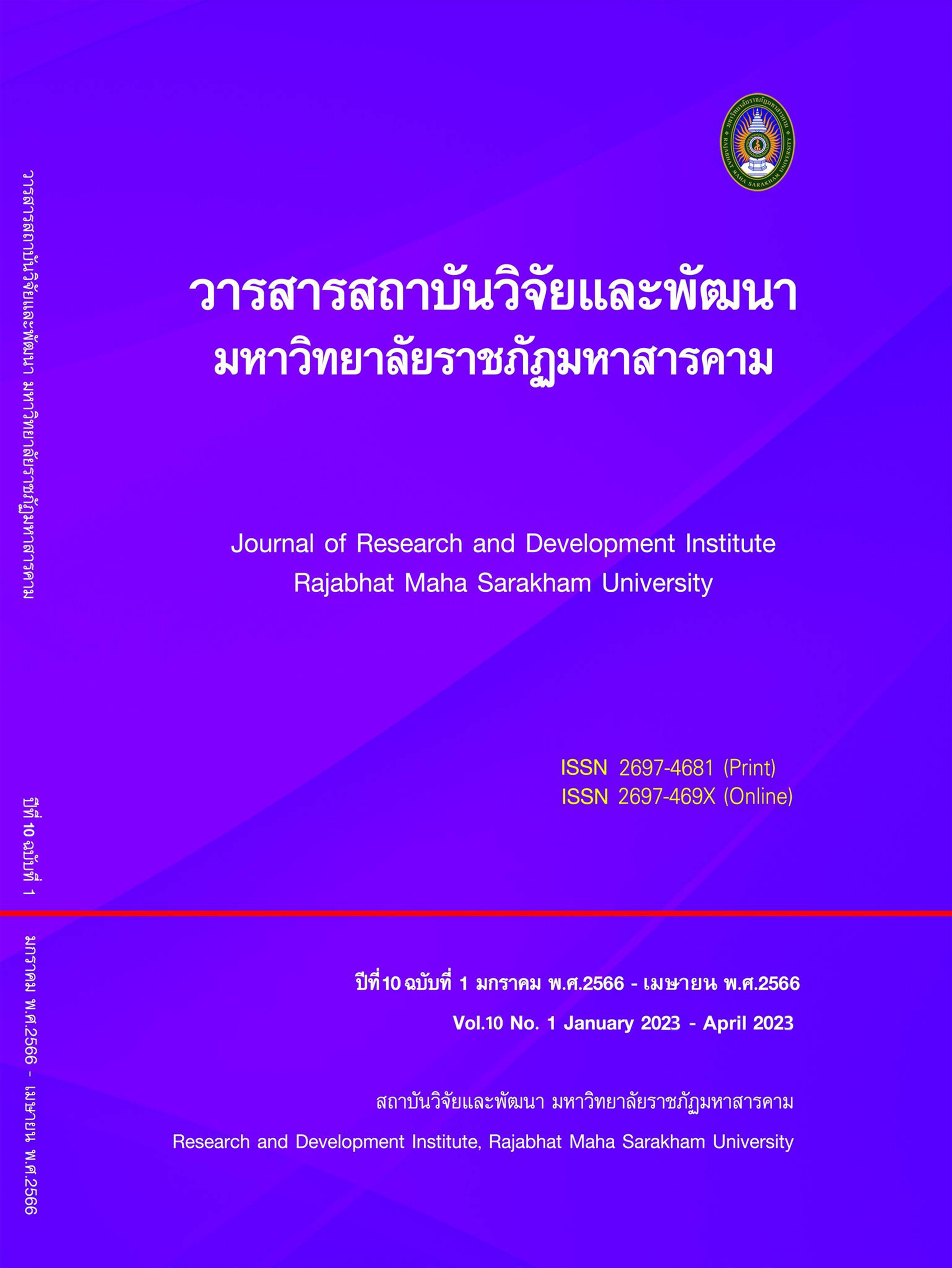รูปแบบการยกระดับประสิทธิภาพการดำเนินงานด้านโลจิสติกส์ของผู้ประกอบการกลุ่มธุรกิจนำเข้าเนื้อสุกรแช่แข็งในประเทศไทย
คำสำคัญ:
การยกระดับ, ประสิทธิภาพการดำเนินงาน, ผู้ประกอบการกลุ่มธุรกิจนำเข้าเนื้อสุกรแช่แข็งบทคัดย่อ
การวิจัยนี้มีวัตถุประสงค์เพื่อ (1) ศึกษาปัจจัยเชิงสาเหตุที่มีอิทธิพลต่อประสิทธิภาพการดำเนินงานด้าน โลจิสติกส์เพื่อให้เกิดความพึงพอใจของผู้ประกอบการกลุ่มธุรกิจนำเข้าเนื้อสุกรแช่แข็งในประเทศไทยและ (2) เพื่อพัฒนารูปแบบการยกระดับประสิทธิภาพการดำเนินงานด้านโลจิสติกส์ที่ส่งผลต่อความพึงพอใจของผู้ประกอบการกลุ่มธุรกิจนำเข้าเนื้อสุกรแช่แข็งในประเทศไทย การวิจัยนี้เป็นการวิจัยแบบผสมผสาน โดยการวิจัยเชิงปริมาณใช้วิธีการสุ่มตัวอย่างแบบแบ่งชั้นภูมิ จากประชากรจำนวน 17,380 ราย โดยกำหนดขนาดกลุ่มตัวอย่างตามเกณฑ์ของแฮร์ และคณะ ซึ่งกลุ่มตัวอย่างได้แก่ ผู้ประกอบการธุรกิจนำเข้าเนื้อสุกรแช่แข็ง จำนวน 380 ราย และการวิจัยเชิงคุณภาพใช้วิธีการสุมแบบเจาะจง จำนวน 15 ท่าน ได้แก่ ผู้ประกอบการ และผู้เชี่ยวชาญ เครื่องมือที่ใช้ในการ เก็บรวบรวมข้อมูล คือ แบบสอบถาม สถิติที่ใช้ในการวิจัยครั้งนี้ คือ ค่าร้อยละ ค่าเฉลี่ย ค่าส่วนเบี่ยงเบนมาตรฐาน และการวิเคราะห์โมเดลสมการโครงสร้างโดยโปรแกรมลิสเรล
ผลการวิจัย พบว่า (1) การจัดการโลจิสติกส์ เทคโนโลยีสารสนเทศ การตลาด ประสิทธิภาพการดำเนินงานด้านโลจิสติกส์ และความพึงพอใจของผู้ประกอบการ สอดคล้องกับข้อมูลเชิงประจักษ์โดยมีค่าดัชนีความกลมกลืนทั้ง 6 ดัชนีที่ผ่านเกณฑ์การยอมรับ คือค่าดัชนี c2/df = 1.203, CGI = 1.00, GFI = 0.97, AGFI 0.95, RMSEA = 0.021 และ SRMR = 0.042 ดังนั้น จึงสรุปได้ว่าแบบจำลองสมการเชิงโครงสร้างมีความเหมาะสมและกลมกลืนกับข้อมูลเชิงประจักษ์ และ (2) รูปแบบการยกระดับประสิทธิภาพการดำเนินงานด้านโลจิสติกส์ของผู้ประกอบการกลุ่มธุรกิจนำเข้าเนื้อสุกรแช่แข็งในประเทศไทย ได้แก่ การจัดการโลจิสติกส์ เทคโนโลยีสารสนเทศ การตลาด ประสิทธิภาพการดำเนินงานด้านโลจิสติกส์ มีอิทธิพลต่อความพึงพอใจของผู้ประกอบการ ดังนั้นผู้ประกอบการสามารถนำรูปแบบที่ได้จากการวิจัยไปใช้เป็นแนวทางในการดำเนินธุรกิจได้อย่างยั่งยืน
References
Abdullah, N, & S, Yaakub. (2014). Reverse Logistics: Pressure for Adoption and The Impact on Firm's Performance. International Journal of Business and Society. 15(1), 151-170.
Aitken, J., & Harrison, A. (2012). Supply governance structures for reverse logistics systems. International Journal of Operations & Production Management. 33(6). pp. 745-764.
Alarm, A., Bagchi, P, K, Kim, B., Mitra, S., & Seabra, F. (2014). The mediating effect of logistics integration on supply chain performance A multi-country study. The International Journal of Logistics Management. 25(3). 553-580.
Aydın. (2014). Envisioning E-logistics Developments in Turkey on The Way of Accession to The EU: A Focus Group Study. International Journal of Academic Research in Business and Social Sciences. 4(7), ISSN: 2222-6990, Barrera & Mejia.
Boonlar, T., & Nimitphuwadol, N. (2019). Logistics Management: Supply Chain Dimension. Bangkok: SE-EDUCATION.
Boonritthiphon, K. (2010). The strategic logistics service development of a transportation company. Master of Science in Logistics Management: King Mongkut's University of Technology Thonburi.
Charoenmas, A. (2012). Developing the potential of rural roads to enhance logistics management efficiency of road freight forwarders along the Pa Sak River, Nakhon Luang District, Phra Nakhon Si Ayutthaya Province. Phanakhon Si Ayutthaya Rajabhat University.
Cojocariu. (2013). The Reverse Gear of Logistics. Review of International Comparative Management. 14(1).
Datta et al. (2013). Microwave-assisted solubilization of inclusion bodies. Sustainable Chemical Processes. I(2).
Daugherty, Myers & Richey. (2002). Information Support for Reverse Logistics: The Influence of Relationship Commitment. Journal of Business Logistics. 23(1).
Draskovic. (2013). Organization of Outsourcing in Logistics Partnership Between The Seaports of Montenegro and Slovenia. Montenegrin Journal of Economics. 9(1), 93-114.
Gracht, H. and Darkow, I.-L. (2013), "The future role of logistics for global wealth – scenarios and discontinuities until 2025", Foresight, Vol. 15 No. 5, pp. 405-419. https://doi.org/10.1108/FS-05-2012-0031
Hair et al. (1998). Multivariate Data Analysis. 7th ed. Upper Saddle River, NJ: Prentice-Hall.
Hazen & Bryd. (2012). Toward creating competitive advantage with logistics information technology. International Journal of Physical Distribution & Logistics Management. 42(1), 8-35. Emerald Group Publishing Limited.
Huscroft et al. (2012). Reverse logistics information system success and the effect of motivation. International Journal of Physical Distribution & Logistics Management. 44(3), 201-220. Emerald Group Publishing Limited.
Jensen, J, K., K, B, Munksgaard, and J, S, Arlbjørn. (2013). Chasing value offerings through green supply chain innovation. European Business Review. 25(2), 124-146.
Kanjanawasee, S. (2002). Assessment theory. Bangkok: Chulalongkorn University Press
Nagy, G., Wassan, N., & Salhi, S. (2012). The vehicle routing problem with restricted mixing of Deliveries and pickups. New York: Springer.
National Statistical Office (2021). NSO Infographic Booklet 2021. Bangkok: National Statistical Office.
National Statistical Office, (2020). Survey of household socio-economic conditions 2019. Bangkok: National Statistical Office.
Office of Business Development, Department of Business Development. (2021). National strategy in logistics and national security. First Edition, Bangkok: Center for Strategic Studies, National Defense Academy.
Office of the National Economic and Social Development Board. (2016). Driving the National Economic Development Plan. Bangkok : Srinakharinwirot University.
Panagiotidou, Nenes & Zikopoulos. (2013). Optimal procurement and sampling decisions under stochastic yield of returns in reverse supply chains. OR Spectrum. 35, 1-32.
Rogers & Tibben-Lembke. (1998). Going Backwards: Reverse Logistics Trends and Practices.The University of Nevada, Reno Center for Logistics Management.
Rutner, S.M., Aviles, M. & Cox, S., (2012). Logistics evolution: a comparison of military and commercial logistics thought. The International Journal of Logistics Management. 23(1), 96-118.
SCB Economic Intelligence Center. (2014). Keep Watching on Competitive Situation of Grocery Store [Online]. Retrieved January 15, 2016, from http://www. scbeic.com/th/detail/product/289.
Stock, J. R., & Lambert, D. (1997). Fundamentals of Logistics Management. New York: McGraw-Hill/Irwin.
Stock, J. R., & Lambert, D. (1998). Fundamentals of Logistics. New York: McGraw-Hill/Irwin.
Wanitbancha, K. (2014). Using SPSS for Windows to analyze data. Bangkok: Faculty of Commerce and Accountancy, Chulalongkorn University.
Zaarour et al. (2014). A Reverse Logistics Network Model for Handling Returned Products. International Journal of Engineering Business Management. 6(13), 1-10.
Zhang, Zhang & Liu. (2013). Energy-based evaluation of system sustainability and ecosystem value of a large-scale constructed wetland in North China. Environ Monit Assess. 185, 5595-5609.
Downloads
เผยแพร่แล้ว
How to Cite
ฉบับ
บท
License
Copyright (c) 2023 สุดารัตน์ มณีโชติ, บุรพร กำบุญ, ศิริพร สัจจานันท์, ฐนันวริน โฆษิตคณิน

This work is licensed under a Creative Commons Attribution-NonCommercial-NoDerivatives 4.0 International License.
บทความที่ได้รับการตีพิมพ์เป็นลิขสิทธิ์เป็นของผู้ประพันธ์บทความ






